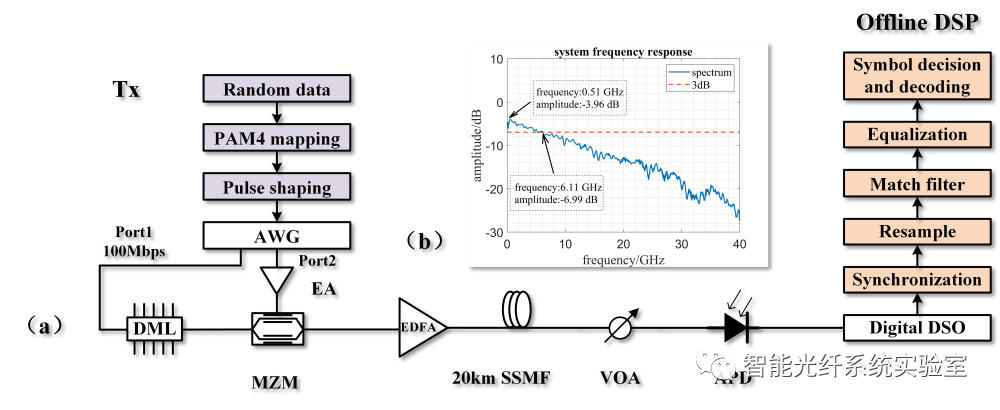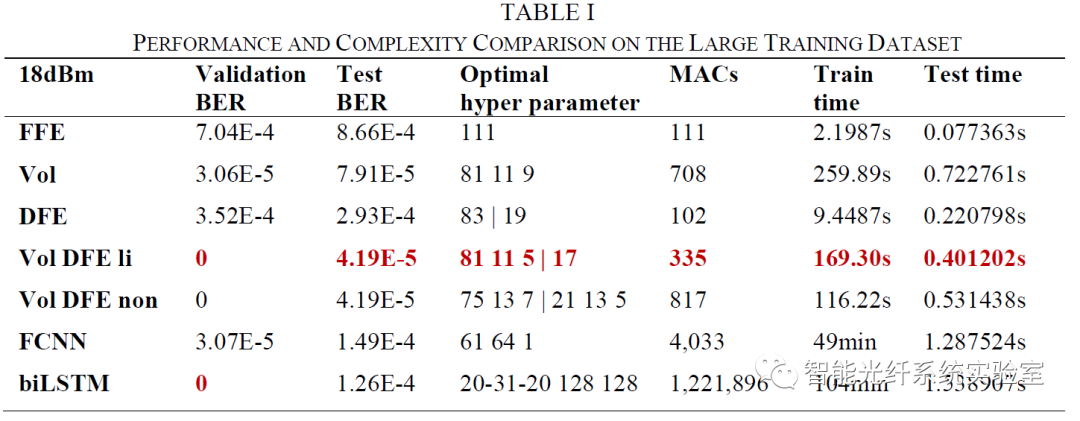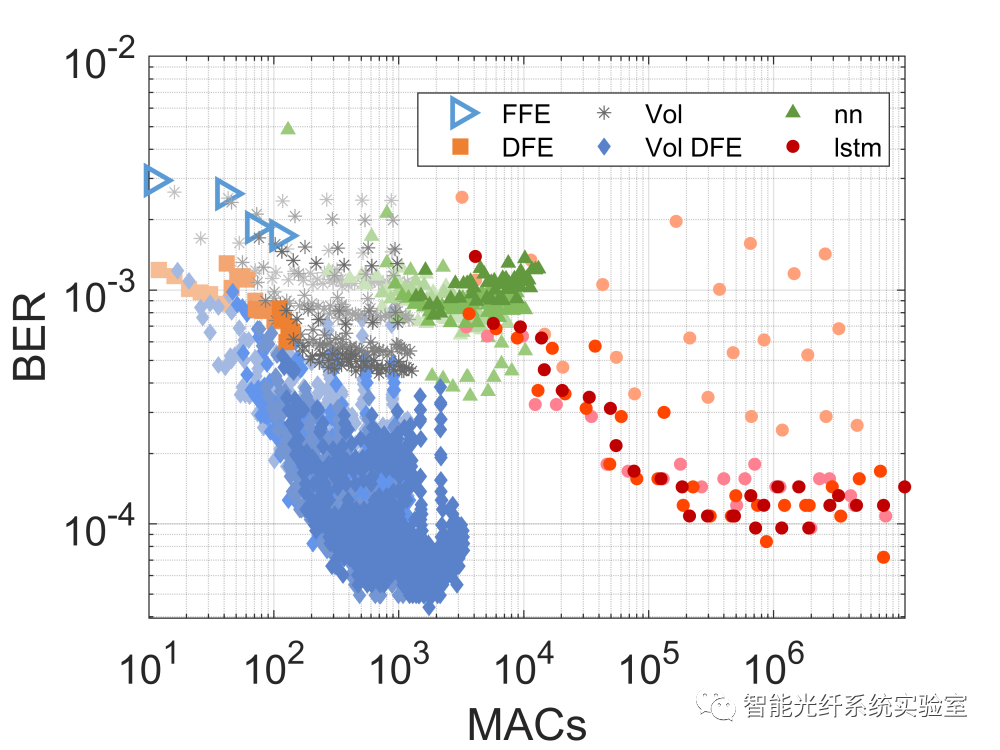Location:Home > News Center >Traditional equ...
Traditional equalizer or neural network equalizer, who is more suitable for direct detection optical communication system?

Recently, the research group of Professor Lilin Yi from the Department of Electronic Engineering of Shanghai Jiao Tong University (LIFE, Laboratory of intelligent fiber ecosystem) studied the traditional equalizer and the neural network equalizer in the 10G band-limited intensity modulation direct detection 50G optical access system (IMDD 50G PON ) in terms of performance, complexity and optimization difficulty, and draw the conclusion that the decision feedback Volterra (Vol-DFE) equalizer has comprehensive advantages, and the Vol-DFE equalizer is used to achieve a power budget of 38dB. The relevant results were published in the international optical journal "Journal of Lightwave Technology" (early access) in April 2022 under the title "Performance and complexity analysis of conventional and deep learning equalizers for the high-speed IMDD PON". Doctoral student Huang Luyao is the first author, and Professor Lilin Yi is the corresponding author.
Research Background
As the demand for bandwidth continues to increase, the rate of the optical access network (passive optical network, PON) is gradually increasing, from GPON to 10GPON to 25GPON. At present, the single-wavelength 50Gb/s PON standard is also in the process of improvement. Since the PON is close to the user side, the cost becomes a big limiting factor, and many low-cost solutions have been proposed, among which the intensity-modulation and direct-detection (IMDD) technology can compensate for various system impairments (such as band-limited , dispersion, nonlinear) digital signal processing (DSP) is regarded as a very promising solution.
At present, the DSP equalizer of IMDD PON is divided into two categories, one is the traditional equalizer, and the other is the deep learning equalizer. Traditional equalizers include feed-forward equalizer (feed-forward equalizer, FFE), decision feedback equalizer (decision feedback equalizer, DFE), Volterra equalizer (Volterra equalizer, Vol) and decision-feedback Volterra equalizer (Volterra DFE equalizer, Vol-DFE), where Vol-DFE is better than other traditional equalizers because it can equalize the nonlinearity and compensate the intersymbol interference of the equalized signal at the same time; the more effective deep learning equalizer in the communication scene is Fully-connected neural network (fully-connected neural network, FCNN) and long short-term memory network (long short-term memory, LSTM), among which LSTM is currently the best equalizer. The question arises naturally: Vol-DFE and LSTM, who is more suitable for IMDD PON? What is the standard of comparison?
Research Path

Figure 1 (a) Diagram of experimental device, (b) Frequency response curve of back-to-back system
In order to know whether Vol-DFE or LSTM is more suitable for IMDD PON, we comprehensively compared Vol-DFE and LSTM in the 50G PAM4 IMDD PON system (Figure 1), and also added FFE, DFE, Vol and FCNN as references. The system rate is 50Gb/s, the back-to-back 3-dB bandwidth is only 6.11GHz, and the band-limiting effect is serious; the system works in the C-band, the fiber transmission is 20 kilometers, and the dispersion damage is serious; the maximum input power of the system is 20dBm, and the nonlinear damage is serious. Therefore the equalizer needs to equalize the band limitation, dispersion and nonlinear impairments simultaneously.
Before the comparison, we discussed three comparison criteria: performance, complexity, and optimization difficulty, and two comparison premises: the algorithm uses consistent data and the equalizer is optimized as much as possible, and strives for a comprehensive and fair comparison. draw relatively objective conclusions.
Research Results

Figure 2 Fiber input power curve: (a) BER of validation set for large training set, (b) BER of test set for large training set, (c) BER of validation set for small training set, (d) BER of test set for small training set code rate. Sensitivity curves: (e) BER for validation set with large training set, (f) BER for test set with large training set, (g) BER for validation set with small training set, (h) test set for small training set Set bit error rate.
The relationship between bit error rate and transmit power is shown in Fig. 2(a)-(d). In the verification set results under a large training set, Vol-DFE and LSTM are the best equalizers. However, in the test set results shown in Figure 2(b), the traditional equalizer has more advantages. The performance difference is caused by imperfect channel estimation. At the same time, due to the dependence of FCNN and LSTM on data, as shown in Figure 2(c)(d), if the training data set becomes smaller, the performance of the deep learning equalizer will be worse. The result of the sensitivity curve is consistent with the result of the fiber input power. On a large training data set, both LSTM and Vol-DFE can obtain a sensitivity of -20 dBm, which is lower than the 7% overhead hard decision forward error correction bit rate of 3.8e-3 threshold. On the small training dataset, the sensitivity of Vol-DFE is still -20 dBm, while that of LSTM is -19.5 dBm, with a loss of 0.5 dB due to dataset reduction. With a transmit power of 18 dBm, a system power budget of 38 dB can be achieved using Vol-DFE.

Table 1 Comparison of performance and complexity of different equalizers on training set and test set
Table 1 summarizes the required MAC, training and testing time for nonlinear equalizers LSTM, Vol-DFE, Vol and FCNN. For the bit error rate of the verification set, the performance ranking is LSTM ≌ Vol-DFE > Vol ≌ FCNN , indicating that LSTM and Vol-DFE have similar performance, and are better than FCNN and Vol with similar performance; for the bit error rate of the test set, The performance ranking is Vol-DFE > Vol > LSTM ≌ FCNN, in which the performance of the traditional equalizer is better than that of the deep learning equalizer. For multiply-accumulate complexity (MAC), the order from small to large is Vol ≌ Vol-DFE < FCNN < LSTM, where deep learning equalizers have higher complexity. For runtime, sorting from short to long is also Vol ≌ Vol-DFE < FCNN < LSTM, consistent with complexity.

Figure 3 The relationship between complexity and bit error rate of different equalizers
At the same time, the complexity models of various equalizers are also tested and shown in Figure 3, where different colors represent different equalizers, and the same color from light to dark indicates that the number of input nodes increases from 11 to 111. At similar complexity, DFE outperforms FFE. For the same complexity, Vol's performance is close to DFE, and continuing to increase complexity can outperform DFE. FCNN is an order of magnitude more complex than Vol, but without significant performance gains. Compared with other equalizers, Vol-DFE and LSTM have significant performance advantages, but Vol-DFE complexity is much lower than LSTM. The performance of Vol and FCNN is comparable without limiting the complexity, because the second-order nonlinearity induced by the square-law detection of PD dominates in the IMDD system, and there is a small amount of third-order nonlinearity in the fiber .
By comparing various equalizers in the IMDD PON system, we found that Vol-DFE is the equalizer with the strongest comprehensive advantages. The equalization scheme based on Vol-DFE realizes a PON system with high power budget and low complexity, which can effectively reduce the overall system cost. At present, the complexity of the Vol-DFE equalizer is further reduced based on reinforcement learning, laying the foundation for the realization of a real-time FPGA system with extremely limited algorithm resources. This solution maximizes the equalization of the receiving end. In the future, it plans to study an end-to-end equalization global optimization system to continuously improve the performance of the optical access network.
The LIFE research group has been committed to the algorithm design, system architecture design, and intelligent development of optical fiber communication systems. At present, the research group conducts in-depth research on channel equalization in the optical access network, automatic optimization of the equalizer by reinforcement learning, global optimization of end-to-end performance, new P2MP architecture based on coherent detection, and FPGA implementation and deployment, contributing to the sustainable development of the optical access field . The work in this direction is supported by the Outstanding Youth Fund of the National Natural Science Foundation of China (62025503), the Key Research and Development Program of the Ministry of Science and Technology (2019YFB1803803), and the Shanghai Jiaotong University-Huawei Advanced Optical Technology Joint Laboratory.
To understand the principles of the 6 equalizers, IMDD PON experiment details, greedy algorithm and heuristic algorithm optimization process, a complete comparison of performance complexity, and the analysis of the results of Vol being better than NN, please refer to the original article
The full text of the paper: https://ieeexplore. ieee.org/abstract/document/9751344 (early access)

